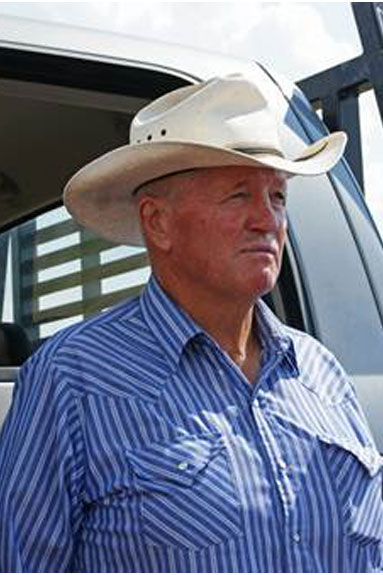
What started as a straight-bred Hereford ranch in Gene’s grandparents' day is a 450-head commercial Salers operation in the 21st century.
Today, the ranch is a partnership between Gene and his family – wife Jill and daughters Jolene and Leslie – and three of his nephews: Dan McHargue, Richard Nelson and Ronald Nelson.
It was Gene’s father that initiated the partnership as a means of bringing in the next generation – at the time, that was Gene and his siblings.
“The value of the property was figured and divided evenly between me and my three brothers,” Gene explains. One of his brothers opted to sell his shares; a second brother passed away and his children, Gene’s nephews, inherited those shares.
But it was Gene’s grandparents who homesteaded the original ranch four generations ago. He gives thanks to both his parents and grandparents for financially managing the operation so it could stay in the family.
“They did a lot of hard work,” he says. “We didn’t have the best of everything, but we had what we needed, lived within our means and were thankful to the Lord for our blessings.”
Some of those blessings include the ability to expand upon the original homestead in order to bring in more family members and diversify the operation. Not only does the 7UD maintain a Salers cow herd, they put up their own feed, raising enough hay to sustain the cows for five months out of the year. They also raise irrigated and dryland grain.
“It’s a dry climate; we only get about 12 inches of rain a year,” Gene explains. “And the winters can be long and hard.”
Despite impeding weather, calving at the 7UD starts Jan. 15th and by the end of February, 80 percent of the calf crop is on the ground. And that’s one of the biggest benefits Gene sees in Salers – fertility.
While he doesn’t think any one breed has it all, “all breeds have something to offer,” he says. He does believe, though, that Salers offer more characteristics suitable to the harsh conditions of Southeast Idaho than any other breed he’s worked with. The 7UD herd runs in the mountains and on pasture, Jolene explains, “and Salers do well everywhere.”
The calves also perform exceptionally well in the environmental conditions. An operation that sells calves off the cow, the 7UD averages a 700-lb. weaning weight on their steers. Not only that, Gene says, but some of those calves are coming off of 15- or 16-year-old cows or were raised as twins.
“As long as they’ll raise a calf, we’ll keep them,” he says. “I just don’t think you can beat their longevity.”
Or the milking ability of some. Gene’s convinced “a good bunch of cows will speak for themselves,” and those that wean twins do just that. “We have 15 to 20 sets of twins every year,” he explains.
If it’s a cow they feel can raise a set of twins, they leave her close to the home place on the best pasture they have. Some mothers of two may give up a calf as a graft and head out to the big pasture with one.
One of Gene’s favorite stories is about a cow that weaned off a set of twins averaging 705-lb. each, and then bred back right away the next two years. “She never skipped a beat,” he says. “We’ve actually had several cows do that.”
And with three to five cows a year raising and weaning twins – in addition to the ones who birthed twins – it’s no wonder that on several occasions the 7UD has weaned a calf crop above 100 percent.
That exceptional calf crop is generally contracted in July for delivery in October. A local feeder buys the calves much of the time and, depending on weights, either backgrounds or puts the calves directly into the feedyard. When they’re finished, they make the short ride to harvest at Hyrum, Utah.
The cooler is another place Gene has seen the advantages of Salers breeding. After seeing the data, he’s learned that almost all of his commercial Salers cattle are Yield Grade 1s and 2s.
Gene, who also continues his cattle education through frequent review of industry publications, can’t quite put his finger on why more producers aren’t using Salers genetics.
“The only thing I can think of is that when they first got started they had a reputation as being wild,” Gene surmises. But, he says, “Registered producers have taken care of that; it’s just not the case anymore.”
Gene will tell anyone that he’s had no more trouble handling Salers than he did Herefords years ago.
Jolene echoes her father and adds, “handling the cattle on horseback also makes them easier to work with and keeps them that way. Salers cattle are just as good to work with as any other breed.”
Based on his success with Salers and the success of the 7UD Ranch, Gene thinks the future looks bright for the cattle industry – especially the cow-calf man – which is why he’s very satisfied with where the ranch is at right now.
With a real desire and love for cattle, he says, “it provides the kind of life I wanted for my family; to me, that’s the most important thing.”
While he and his immediate family love cattle and have all their lives, he’s knows it’s inevitable some changes will take place at the ranch in the future. His girls are home helping and while his nephews are an equal and important part of the operation, their passion is more for farming.
But no matter what happens, the generation’s deep and rich history of the 7UD Ranch will be a part of the Salers and cattle community. ![]()
—From American Salers Association news release
PHOTO
Gene Nelson of the 7UD Ranch, Rockland, Idaho. Photo courtesy of American Salers Association.






